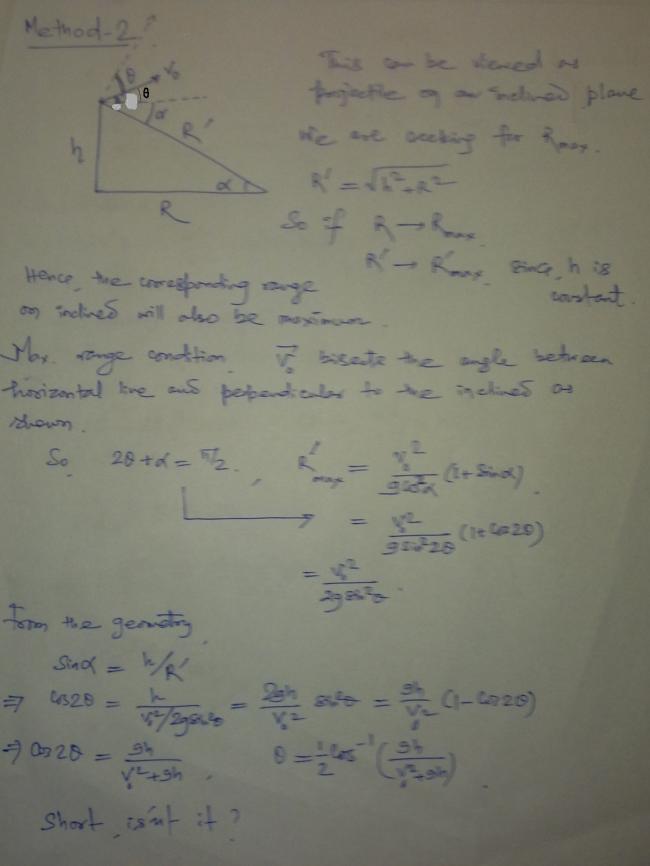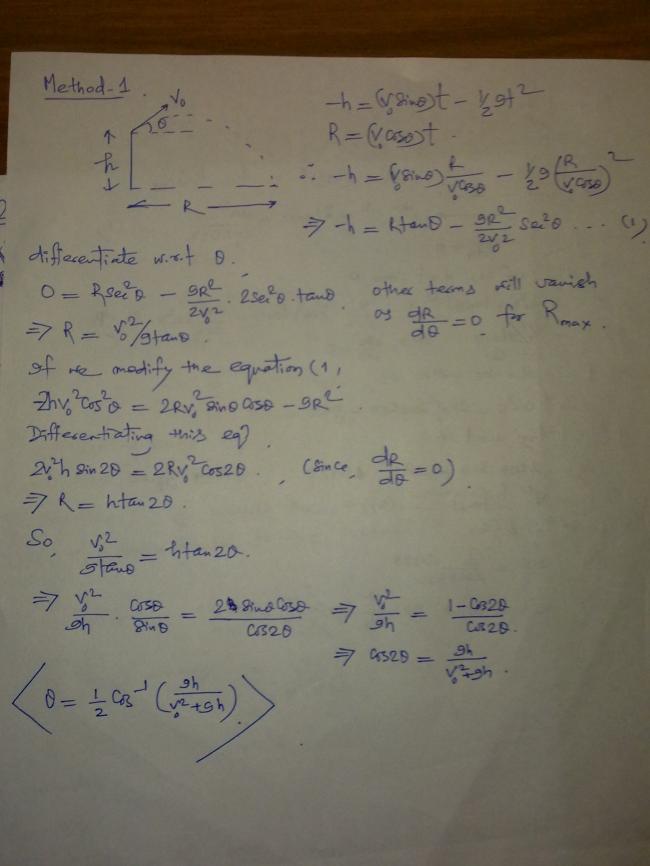R^{2}=h^{2}+\frac{2v^{2}[sin\theta \sqrt{R^{2}-h^{2}}+hcos\theta ]cos\theta }{g}
i got something like dis
A projectile is fired from height h with a speed V0.What is thje angle of projection so that range is maximum ?
R^{2}=h^{2}+\frac{2v^{2}[sin\theta \sqrt{R^{2}-h^{2}}+hcos\theta ]cos\theta }{g}
i got something like dis
mine ans. is also same.....since cos-1x + sin-1x = pi2....using this,,we will get the same ans......
it is the same thing to wat i hav written in #11
also see http://www.targetiit.com/iit-jee-forum/posts/mechanics-doubt-17302.html [3] [3] .... same result


There is so much literature on projectiles..If you guys are interested I can post some more..
finally i am getting....
\large required\,angle=\frac{\Pi }{4}-\frac{1}{2}\sin^{-1} (\frac{gh}{gh+v_{0}^2})
so using above relation we can find angle \phi in terms of h and u.....
then we can apply the condition for maximum range on inclined plane......and find the required angle ..............
sir i hv edited my post......in the given eq. \phi is the inclination of the assumed inclined plane with the horizontal....its not the inclination of V0 with the horizontal....
born your expression seems to give infinity as the answer....??
are you applying the whole thing correctly?
\large R_{max}=\frac{v_{0}^2}{g(1-sin\phi ) }
write eq. for range down an inclined plane nd then find its max. value.....u will get the above equation.
don't worry about height h given in the problem......u can easily relate 'h' with the above eq. by trigonometric relations.....
i.e in the given problem we can write...
\large \frac{h}{sin\phi }= R_{max}
N.B→ in the above eq. \phi in the inclination of the imaginary inclined plane....
simple application of maxima and minima ...
vertical component of velocity =vosinθ
and horizonal component of velocity = vocosθ
where θ is the angle of projection with the horizontal axis!
now, applying principles of kinematics for constant and zero acceleration,
-h = (vosinθ)t - 12gt2
gives t = vosinθ±√vo2sin2θ+2ghg
now, range R= vocosθ.t = vocosθ.vosinθ±√vo2sin2θ+2ghg
now using derivatives as tool to find maxima, we fing maximum range related θ
by, ddθR=0
and, ddθ.ddθR<0
genius mathematicians help me out with this hefty mathematical part (to solve it un-erronously and easily if there is another way in their mind! :P)
But the question demands a short answer :(
yup (enuf interfering in satya's post... :P) until he is around to reply.. or someone gives the right answer
no qwerty... not this one.. thsi one is if it were a plane..
here we have a height "h"
The formula I was referring to was
y=x...-gx2... (still not able to figure out?)
Range=vo2sin2A/g
A = angle of projection
hence for given vo,range will b max when sin2A = 1
so A = 45o
I dont know if kaymant sir is hinting at the same..
but i guess there is only one formula to learn in this chapter called projectiles... [3]
this sum can be solved easily by assuming an imaginary inclined plane nd using the condition for maximum range down an inclined plane.........